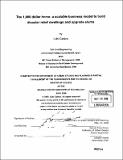| dc.contributor.advisor | Dennis Frenchman. | en_US |
| dc.contributor.author | Cañzio, Luis (Del Cañzio) | en_US |
| dc.contributor.other | Massachusetts Institute of Technology. Dept. of Urban Studies and Planning. | en_US |
| dc.date.accessioned | 2007-09-28T13:06:45Z | |
| dc.date.available | 2007-09-28T13:06:45Z | |
| dc.date.copyright | 2006 | en_US |
| dc.date.issued | 2006 | en_US |
| dc.identifier.uri | http://hdl.handle.net/1721.1/38916 | |
| dc.description | Thesis (S.M.)--Massachusetts Institute of Technology, Dept. of Urban Studies and Planning, 2006. | en_US |
| dc.description | Includes bibliographical references (leaves 61-62). | en_US |
| dc.description.abstract | This thesis proposes a new model for the private markets to build disaster relief dwellings or to upgrade degraded neighborhoods of very low income communities. The study offers a way to empower the dwellers of very poor communities or the victims of natural disasters not only by providing them with financial support, but equally important by also providing them with a construction method that allows for a progressive build up of their dwellings. In doing so, the author argues that the residents of poor, informal settlements could act as developers of good quality housing and successfully improve their communities. The analysis leading to the proposed new model is based on the following: 1. A review of other private sector precedents to empower the communities of impoverished settlements or victims of natural disasters. Such precedents have had varying degrees of success, and illustrate the difficulties in implementing a method that can be scaled up universally to meet the overwhelming need for low cost housing. 2. A specific technical solution to build low cost houses by relying on the use of stabilized earth compacted and packaged into polypropylene skin, forming a continuous durable brick, as the main construction material and a self-build approach that can guarantee the affordability while also providing for a safe and good quality dwelling unit. | en_US |
| dc.description.abstract | (cont.) 3. A valid economic model that can be adopted by private entities, either for profit or non-profit. The proposed economic model focuses on creating for profit firms with social entrepreneurial capital. Such entrepreneurial firms can be scaled up to build large amounts of housing units. The business model has three different phases. First the clients will be NGOs doing development or emergency relief. Second, once footprint has been established, the clients will be multinational corporations that want to optimize their corporate social responsibility strategy. This multinationals will finance the projects of the new ultra-low-cost housing development firms as an indirect way to benefit their stakeholders, to increase their brand recognition and goodwill, or to do damage control. Third, the economic model will consider the dweller as the paying party. That will be achieved by adding microfinance service for the poor. | en_US |
| dc.description.statementofresponsibility | by Luis Canizo. | en_US |
| dc.format.extent | 62 leaves | en_US |
| dc.language.iso | eng | en_US |
| dc.publisher | Massachusetts Institute of Technology | en_US |
| dc.rights | M.I.T. theses are protected by copyright. They may be viewed from this source for any purpose, but reproduction or distribution in any format is prohibited without written permission. See provided URL for inquiries about permission. | en_US |
| dc.rights.uri | http://dspace.mit.edu/handle/1721.1/7582 | |
| dc.subject | Urban Studies and Planning. | en_US |
| dc.title | The 1,000 dollar home : a scalable business model to build disaster relief dwellings and upgrade slums | en_US |
| dc.title.alternative | One thousand dollar home : a scalable business model to build disaster relief dwellings and upgrade slums | en_US |
| dc.type | Thesis | en_US |
| dc.description.degree | S.M. | en_US |
| dc.contributor.department | Massachusetts Institute of Technology. Department of Urban Studies and Planning | |
| dc.identifier.oclc | 124508118 | en_US |

